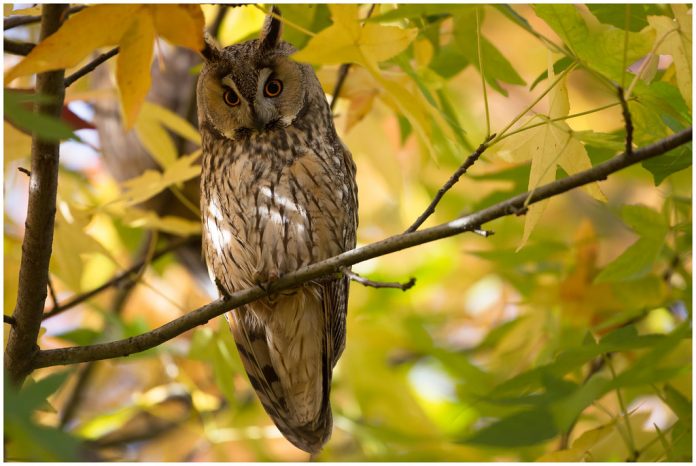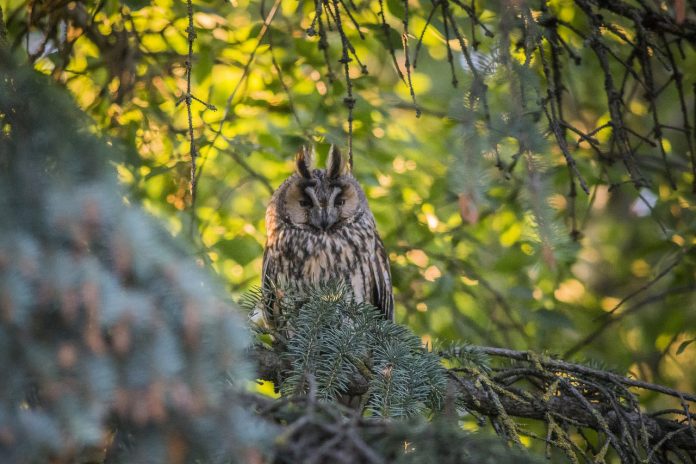LONG-EARED OWL SOUND / CALL
The males (boomers) make a deep hooting noise. Females (Kleeers) make a trilling, multi-note call. The young (kee-kees) make a “raspberry” noise. Rather silent outside breeding season. The advertising call of the male is a repeated, soft, muffled (cooing) but quite far-carrying ‘ooh’; it sounds rather like air being blown into an empty bottle.
The long-eared owl sound, the first call of the series, is typically softer and lower-pitched. Female gives a very weak, nasal (lamb-like), drawn-out ‘paah’ or ‘peh-ev’. Alarm calls are sharp, barking ‘kvik kvik kvik’ and yelping or squealing sounds. Begging call of young a shrill, mournful, drawn-out, and far-carrying ‘peeeeeeee’, sounding rather like the noise of a gate with squeaky hinges.
DESCRIPTION
The long-eared owl’s habitat is open country with low vegetation, such as meadows, marshes, prairies, farmland, and tundra. Long-eared owls have two different color phases: rufous and gray/brown. They have prominent ear tufts and yellow eyes. They have a white throat, and the long ear tufts are black. Their belly is heavily barred, and they have a stripe from the beak to the eyes. The underside of the wings is much lighter than in other phases, with a black patch on the shoulder area.
Long-eared owls are solitary, but they do move in loose groups when food is plentiful. They roost during the day and hunt at night. Long-eared owls make a variety of calls depending on their age and sex. Male long-eared owls, called boomers, are larger than female long-eared owls, called kleeers. Boomers are also more aggressive than kleeers. They perform aerial displays in the presence of an intruder to the territory, with lots of screeching and diving.

The long-eared owl usually hunts by perching on a branch or on the ground, watching for prey. It swoops down on prey with a nearly imperceptible swoop and snatches it up in its talons.
IDENTIFICATION
A long-eared owl (Asio otus) is a medium-sized owl with long ear tufts and pale, yellowish-orange eyes. It is slightly smaller than Tawny and longer- and narrower-winged. Easily distinguished by ear tufts (although these are not visible in flight and are sometimes hard to see if lowered when perched), pale eyes, lack of tapering dark stripe from crown to bill, more clean-cut streaking on underparts, and striking wing pattern with contrasting dark carpal patches and pale, a golden-buff panel on the base of primaries on the upper wing and a conspicuous dark crescent on the carpal area on the underwing. The confusion is much more likely with similar short-eared
When perched and long ear tufts are visible, separation is easy, but when tufts are lowered and hard to see, they must rely on the larger head with yellowish-orange rather than yellow eyes and rather uniform dark streaking on the entire underparts, not heavily concentrated on the throat and breast. Facial expression ranges from round-faced and wide-eyed, rather like typical short-eared, to rather long and pinched when half-asleep.
Inflight has slightly broader, more rounded wings, but this difference is not easy to appreciate in the field. Wing patterns differ, however. The upper wing lacks a whitish trailing edge on the secondaries and inner primaries of Short-eared, and while both have a dark carpal patch, Long-eared has finer and more extensive, less blackish barring on the ends of primaries and has a less extensive, warmer-colored pale panel on primary bases. It lacks the sharp contrast shown between the very dark wingtip and the extensive pale panel shown by Short-Eared.

On the underwing, both show conspicuous dark crescents on the carpal area, but, as with the upper wing, the long-eared has a finer and more extensive, less blackish barring near the wingtip, lacking the obvious solid blackish wingtip of the short-eared. Barring on the tail is also less obvious, and upperparts, in general, look less variegated. Long-eared owl flight is rather leisurely, almost gull-like, with several slow, stiff wing beats alternating with long glides, banking, and side-slipping. Generally glides with wings held level.
The flight action is quite different from Tawny’s but close to that of Short-Eared. A long-eared owl is rarely active in the daytime except on migration. Small numbers will roost together in the winter. Generally, they reside in the nests of old corvids.
SEX/ AGE
Adult females are usually more richly colored on the facial disc and underparts, more boldly dark-streaked on the upperparts, and underwing coverts are rich buff instead of whitish. The juvenile owl at fledging resembles an adult as regards facial disc, flight feathers, and tail, retaining much downy feathering elsewhere; head (except facial disc), underparts, upperparts, and wing coverts are whitish-buff, closely but narrowly and rather indistinctly barred with grayish.
Immature may be aged on exceptional view up to first spring owing to retained juvenile flight feathers and tail with extra dark bar (thus 5 bars, rarely 4–6, on outer primaries compared with 3–4, however in rare 5, in adults, and 5–6 bars on tail beyond upper tail coverts compared with 4 in adults).

STATUS/HABITAT
Generally, this owl is fairly common but locally scarce. (In addition to mapped range, has bred Majorca and may breed Syria and Lebanon.) Long-eared owls are found in woodlands, copses, thickets, and clumps of trees or small plantations in open country (cultivated or uncultivated), hunting over adjacent open country. It is mainly, but by no means always, associated with conifers. Also, the outside breeding season is (and locally when breeding) in treeless areas such as moorland, coastal dunes, steppe, and semi-desert.
SIZE AND WEIGHT
The average size is about 35–37 cm in length, with a wingspan of 90–100 cm. Weight: 40 ounces to 1 pound. Females are generally larger than males.
TAXONOMY
Kingdom Animalia, Phylum Chordata, Class Aves, Order Strigiformes, Family Strigidae
FOOD
Its prey consists of small mammals, such as moles, shrews, mice, voles, squirrels, and rabbits. Long-eared owls mate in February and March. They usually lay three to five white eggs, spotted with brown, at the larger end of tree cavities or in abandoned nests.
RANGE
The range of long-eared owls includes much of North America, extending south into Mexico. The long-eared owl feather is used in potions and charms, particularly those calling for the tail feathers of hawks. Long-eared owls live near or on the ground, so their feathers are easily found there, usually under hedges or bushes. Long-eared owl feathers are used for divining rods. A long-eared owl feather is also used in some healing rituals.
GEOGRAPHICAL VARIATION
Slight. There are two races
Related Reading: Biak Scops Owl







